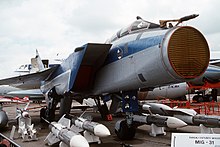Zaslon

MiG-31 showing Zaslon antenna
|
|
| Country of origin | Russia |
|---|---|
| Type | PESA |
| Range | 400 km for 20 m2 RCS(282km for 5 m2) |
| Diameter | 1.4 meters |
The Russian (former USSR) BRLS-8B "Zaslon" (Barrier) is an all-weather multimode airborne radar developed between 1975 and 1980 by the Tikhomirov Scientific Research Institute of Instrument Design as part of the weapons control system of the MiG-31 supersonic interceptor. The NATO codename for the radar is Flash Dance with the designations "SBI-16", "RP-31", "N007" and "S-800" also being associated with the radar.
The Zaslon is a Pulse-Doppler radar with a passive electronically scanned array (PESA) antenna and digital signal processing. The antenna used by the Zaslon is actually a multi-channel system comprising two separate electronically controlled arrays, an X band radar with 1700 emitters and a L band transponder with 64 emitters brought together into a single antenna. The antenna has a diameter of 1.1 meters and is fixed in position with a scanning sector of +/-70 degrees in azimuth and +70/-60 degrees in elevation. The X-band components of the radar uses reciprocal ferrite phase shifters that allow the radar to position beams in around 1.2 ms. This high performance is one of the big advantages of phased array radars compared with the previous generation of mechanically scanned arrays which take seconds to perform the same functions as a phased array. The detection performance of the Zaslon radar is stated to be 200 km against a target with a Radar cross section (RCS) of 16 m2, the radar can track up to 10 targets while engaging 4 of those at any one time with either R-33 radar guided or R-40, R-60 IR-guided air-to-air missiles.
The Zaslon was the Soviet Union's first look-down/shoot-down radar. This made it much harder for United States Air Force aircraft and cruise missiles to penetrate the Soviet airspace at low altitude (through Terrain masking/clutter (radar)), without being detected.
...
Wikipedia
